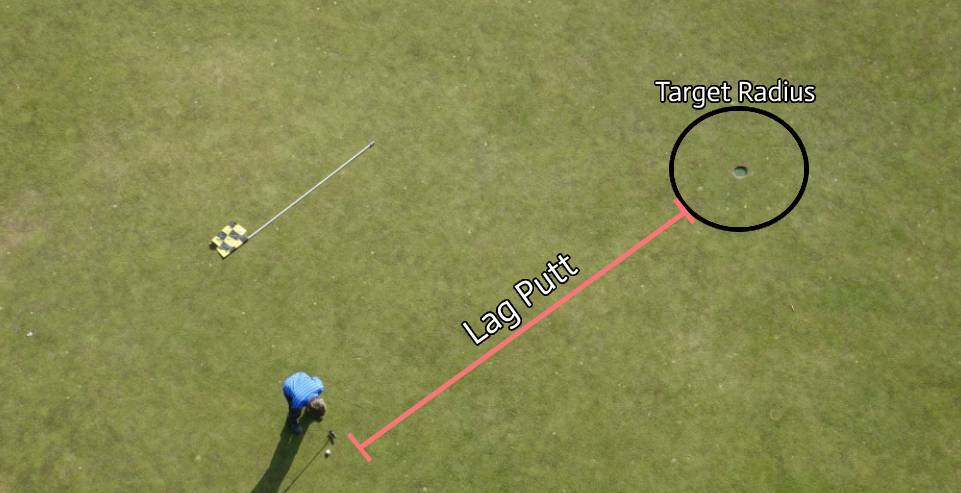If you’ve been trying to shave some points off of your score (specifically putting), you may have come across a strategy known as lagging. As a beginner or an amateur, you may have never heard of this strategy before. So, in this post we show you what a lag putt is, when to use it, and how to practice it. By the end of this post you should know everything about lag putting, which will ultimately help your golf game.
What is a Lag Putt? A lag putt is a putt that you hit just to get close enough to the hole that you’ll have an easy second putt. The purpose of a lag putt is to get the player close enough to the hole to where they can sink their next putt.
The main objective behind lag putting is to avoid the 3-putt. There is nothing that will kill a round like a bunch of three-putts. In some cases, it will cost you a match. You have to recognize when lagging is the best strategy. A good lag putt will get you within a 2 foot radius of the hole. It essentially changes your target from a 4.25 inch hole to a 4 foot circle.

When to Lag Putt
For some golfers, hitting NEAR the hole will yield better results than aiming FOR the hole. More specifically, when you aim for the hole a number of things can go wrong (overshooting, reading the green incorrectly, etc.), which can sometimes place you further from the hole than your previous shot. This is where lag putting is the best strategy. Below are some instances in where lag putting is recommended:
If you have a putt over 25 feet.
Touring pros will only make 10% of their 25 foot putts. Amateurs make considerably fewer. So you really can’t expect to make it. If you do, it’s a bonus. Remember, par is a good score for an amateur. If you’ve hit a green in regulation (in one for a par 3, in two for a par 4, in three for a par 5), all you have to do is two-putt for your par.
If you have a shorter putt, but it’s downhill and very fast
When you’re in this situation, it’s best to try and get near the hole with a lag putt, as it will be very easy to overshoot the ball in this case. Rather than potentially shooting the ball further away on this fast, downhill green, it’s best to lag putt and not risk overshooting.
In match play, if you only need a two putt to win the hole
Simply put, if you are competing in match play and only need a two putt to win the hole, utilizing a lag putt can help ensure you keep it to a 2-putt. In this situation, you’d rather be safe than sorry, making sure you can get yourself close to hole will almost guarantee you don’t 2-putt.
When Not to Lag a Putt
- If you need it to halve a hole in match play.
- If your partner is already in for par, and you’re putting for birdie. (Especially if there’s a skins pool.) Or he’s in for bogey, and you’re putting for par. Or he’s in for birdie, and you’re putting for eagle. You get the idea.
- On the last hole, you need it to tie for a tournament win.
How to Get Better at Lagging (Lag Putting)
Don’t think of it as getting better at lagging. Think of it more as getting better at distance control. If you’re out there in individual stroke play, you want to give all your putts a decent chance. And all your putts count equally — birdie putts, par putts, bogey putts, and even double bogey putts. Keep in mind, a putt that comes up short will never go in.
Before you hit a lag putt, set a goal for how close to the hole you want to end up. https://t.co/Q3hpywwV13
— GOLF.com (@GOLF_com) March 19, 2021
Short game guru Dave Peltz says you should try to hit a putt that would end up 17 inches behind the hole. That gives you the best chance of making while still leaving yourself an easy second putt. Hitting it 17 inches by the hole means you are hitting it firm enough to hold its line. A softer putt will break less predictably and be influenced by spike marks and other imperfections in the green. A harder putt will be more likely to lip out.
How to Practice Lag Putting
For longer putts, speed is much more important than line. You’re probably not going to hit it more than two feet offline, unless you’ve badly misread the putt. So speed is something you should practice a lot. One drill you can do when you’re on a practice green is to get 30, 40, or more feet from the edge of the green and just putt to the edge. See how close you can get to the edge without hitting the fringe. Less than two feet is pretty good.
Developing consistency when it comes to lag putts will save you strokes in the long run. (@erikalarkingolf) pic.twitter.com/2TPNdpuGni
— GOLF.com (@GOLF_com) March 18, 2021
Another drill you can do is put a tee in the putting green at five foot intervals, starting at 20 feet. Have 10 or 20 balls that you can putt to each interval. (This is best done when there aren’t a lot of people around.) Try to notice how far you take your blade or mallet back before striking the ball at each interval. Bear in mind, it will change on different courses with different speeds. But you can dial in speeds at your home course at least.
Today’s LD Tip is a lag putting drill I love. Tour players average 2 putts from 30 ft, so if you can consistently do this drill you are ready for the Tour 😝 #LDTips #lagputting #staysafe #stayhealthy pic.twitter.com/yodSQ9uywC
— Luke Donald (@LukeDonald) May 1, 2020
If you want to practice your putting speed indoors, the VariSpeed Putting System by ProActive Sports is a putting mat that will let you do that. It’s adjustable to different Stimp speeds and different breaks.
Some Final Thoughts On Lag Putting
If you don’t have a lot of time before your round, the most important thing you can do is roll a few 30 footers on the practice green to see how fast they’re rolling. Sometimes the greens on the course may be a different speed from the practice green, but usually they are similar.
Lag putting is a good skill to have. You don’t want to charge all your putts, or you’ll live dangerously.



